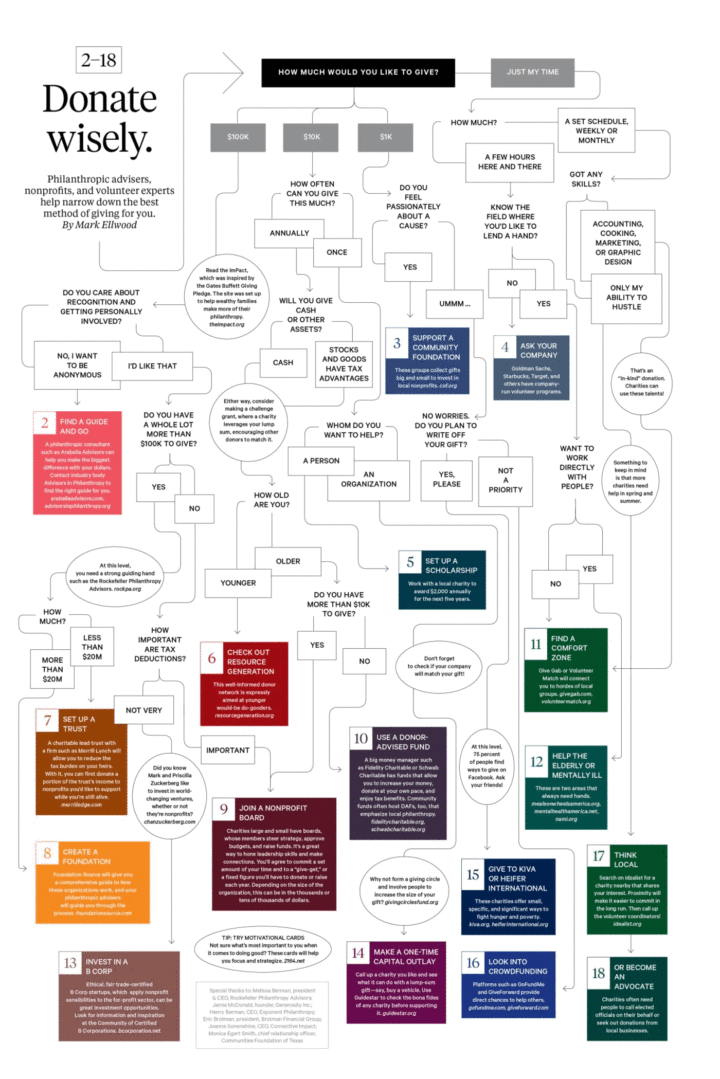If you are looking for some direction about donating your time and/or money, here is a nice infographic from the Bloomberg article These 27 Strategies Will Make Philanthropy an Effective Pursuit (click to enlarge):
It’s from last year, but everything still looks applicable. Also available as PDF.

 The Best Credit Card Bonus Offers – 2025
The Best Credit Card Bonus Offers – 2025 Big List of Free Stocks from Brokerage Apps
Big List of Free Stocks from Brokerage Apps Best Interest Rates on Cash - 2025
Best Interest Rates on Cash - 2025 Free Credit Scores x 3 + Free Credit Monitoring
Free Credit Scores x 3 + Free Credit Monitoring Best No Fee 0% APR Balance Transfer Offers
Best No Fee 0% APR Balance Transfer Offers Little-Known Cellular Data Plans That Can Save Big Money
Little-Known Cellular Data Plans That Can Save Big Money How To Haggle Your Cable or Direct TV Bill
How To Haggle Your Cable or Direct TV Bill Big List of Free Consumer Data Reports (Credit, Rent, Work)
Big List of Free Consumer Data Reports (Credit, Rent, Work)
Keep in mind that this chart measures the status quo. For example, clearly those interviewed generally did not think younger people were fit to serve on non-profit boards.
Most non-profits that I’ve worked with want diversity on their boards, particularly in age. Otherwise you stand to alienate yourself from the younger generation and eventually become extinct. Being a younger member of a non-profit board is a great way to gain wisdom from older members with more experience, while also bringing new energy and contributing fresh ideas.
My kids asked me how I determined who to donate to each year so I put my own personal guidelines on paper for them.
1. If a charitable organization doesn’t use AT LEAST 85% of their funds raised to directly support their programs, I don’t even consider a contribution. I use Charity Navigator for this info.
2. I never give money to a charity sponsored by a celebrity, actor, athlete or politician or to a charitable foundation in a person’s or a family name. Too many of these don’t come close to Rule # 1 and too often the charity is more efficient at providing jobs and benefits to family members instead of those they purport to help.
3. I never give money to some mailing asking for money or someone calling for money since most of the money raised goes to pay for the solicitations; see Rule # 1.
4. I don’t give money to religious charities or charities sponsored by religious figures since they do not have to comply with IRS reporting rules and can’t prove they meet Rule # 1. One exception, I will donate to the Salvation Army since I and other family members have eaten their meals during hurricane relief.
That said, you’re probably wondering just who (if anyone) does this old Scrooge give money to? Well, I believe money is best applied directly to problems. The fewer hands in the way the better, whether it is the Red Cross, Wounded Warrior Project or the US Government.
1. Hard working people. I would rather leave a $5 tip on a $10 breakfast at Waffle House than give to an organization designed to help low income people (such organizations are rarely run by low income people and they rarely meet Rule # 1).
2. Buy lunch for someone that needs it
3. Buy a bag of canned goods and give it to a food bank
4. Give money to a food bank but remember Rule # 1. Here in Phoenix, St. Mary’s Food Bank comes in at 96%. Every dollar you give means 96 cents in program expenditure. That’s pretty good.
One final note on the American Red Cross. The Red Cross tax filings indicate that 90% of their expenditures go to programs. A lot of folks think the ARC accounting is suspect since they mix the contributions with their blood sales business. I know the ARC does good things and I have given them money. I try to target it to hurricane relief since my family has been impacted by hurricanes in the past and will be again in the future.
One more final, final note. Washington has changed the rules for deductions and made it less likely that a charitable contribution will qualify for a deduction on your income taxes. Nevertheless, there are worthy organizations that depend on charitable giving to meet their budgets. If it was a good idea to donate money before the tax law change, then it’s probably a good idea now, in spite of the tax law changes.
Thanks for posting this information Jonathan. As a long time reader of yours, I find this posting very helpful.